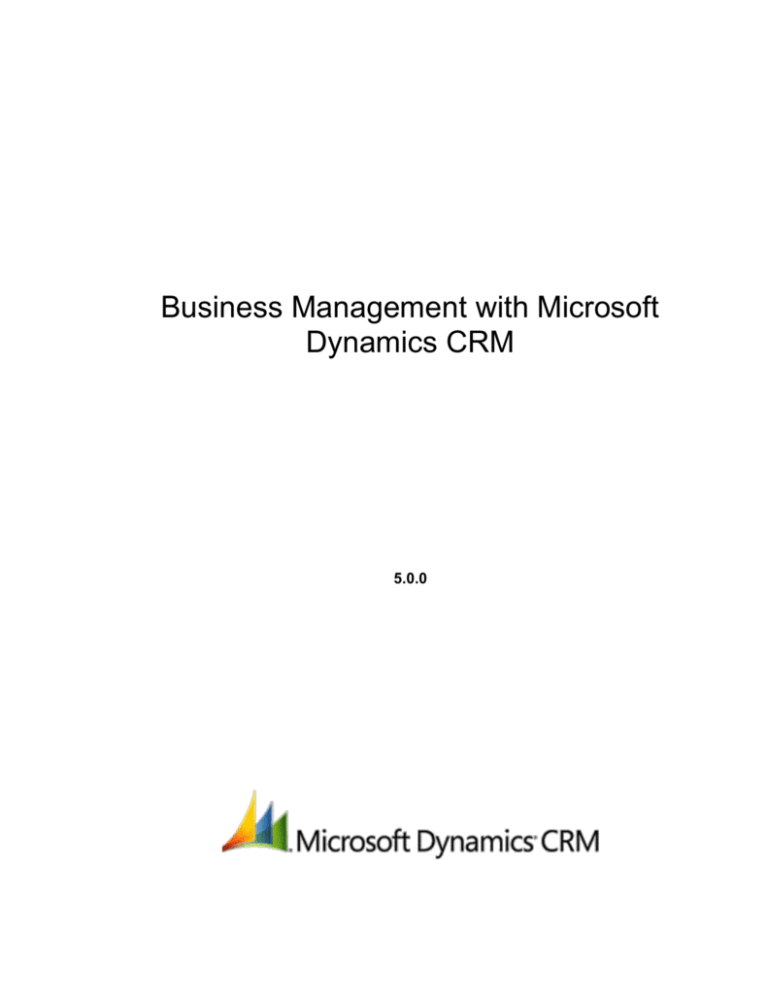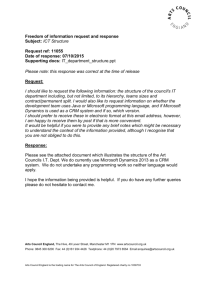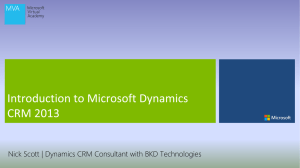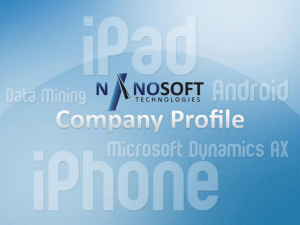
Business Management with Microsoft
Dynamics CRM
5.0.0
Copyright
This document is provided "as-is". Information and views expressed in this document, including URL and other Internet Web site
references, may change without notice. You bear the risk of using it.
Some examples depicted herein are provided for illustration only and are fictitious. No real association or connection is intended or
should be inferred.
This document does not provide you with any legal rights to any intellectual property in any Microsoft product. You may copy and
use this document for your internal, reference purposes.
© 2011 Microsoft Corporation. All rights reserved.
Microsoft, Active Directory, Excel, Hyper-V, Internet Explorer, Microsoft Dynamics, Microsoft Dynamics logo, MSDN, Outlook,
Notepad, SharePoint, Silverlight, Visual C++, Windows, Windows Azure, Windows Live, Windows PowerShell, Windows Server,
and Windows Vista are trademarks of the Microsoft group of companies.
All other trademarks are property of their respective owners.
Contents
Business Manager's Role in a Microsoft Dynamics CRM Implementation .............. 3
Tools, training, and documentation to help you plan ............................................................................... 3
Tools for business management ......................................................................................................... 4
Microsoft Dynamics Sure Step methodology ...................................................................................... 4
Business management training ........................................................................................................... 4
Help ..................................................................................................................................................... 5
Planning a Microsoft Dynamics CRM implementation ............................................................................. 5
Planning tasks for business managers ............................................................................................... 5
Development tasks for business managers ........................................................................................ 6
Deployment tasks for business managers .......................................................................................... 6
Post-deployment tasks for business managers .................................................................................. 6
Managing a Microsoft Dynamics CRM implementation project .......................................................... 7
Implementation overview ......................................................................................................................... 9
Planning .............................................................................................................................................. 9
Development ....................................................................................................................................... 9
Deployment ......................................................................................................................................... 9
Post-deployment: operating and maintaining ...................................................................................... 9
Planning tasks ................................................................................................................................... 10
Deployment tasks .............................................................................................................................. 16
Post-deployment tasks ...................................................................................................................... 17
i
Business Manager's Role in a Microsoft Dynamics CRM
Implementation
Business managers play a key role during all the phases of a successful implementation of Microsoft
Dynamics CRM and Microsoft Dynamics CRM Online: planning, development, deployment, and postdeployment. This chapter describes the role of the business manager in the implementation process and the
planning tools available for that process.
Each organization has a set of business processes unique to that organization. To run smoothly,
organizations should standardize processes across the organization, and encourage all users to follow these
standards. By mapping your business processes to Microsoft Dynamics CRM, you determine areas where
you either have to modify your processes to match Microsoft Dynamics CRM, or configure and customize
Microsoft Dynamics CRM to match your business processes.
Microsoft Dynamics CRM enables you to automate internal business processes by creating work flow rules
that describe routine and repetitive tasks involving daily business operations. These processes can be
designed to make sure that appropriate and timely information is sent to the correct people. They also help
participants keep track of the steps they have to take to complete their work. You must decide which
processes to automate.
When Microsoft Dynamics CRM is deployed in your organization, one of your roles is to make sure that
employees are trained correctly, and that everyone understands their responsibilities for data management.
In addition, because configuration and customization can be done through the user interface in Microsoft
Dynamics CRM, business managers in many organizations are responsible for adding and removing users,
changing security roles to meet employees' data access needs, changing team and queue memberships, and
even customizing the user interface.
After your employees start using Microsoft Dynamics CRM, you must have a process for deciding when
changing business needs require changes to Microsoft Dynamics CRM.
In This Document
Tools, training, and documentation to help you plan .................................................................... 3
Planning a Microsoft Dynamics CRM implementation .................................................................. 5
Implementation overview............................................................................................................... 9
Send feedback ........................................................................................................................... 17
Tools, training, and documentation to help you plan
This section describes the tools, training, and documentation that are available to help you perform the
Business Manager's role in planning a Microsoft Dynamics CRM or Microsoft Dynamics CRM Online
implementation.
3
Business Manager's Role in a Microsoft Dynamics CRM Implementation
Tools for business management
The following table describes tools that you can modify and use for determining how your business processes
map to Microsoft Dynamics CRM. These tools are available for download at Microsoft Dynamics CRM
Planning Tools (http://go.microsoft.com/fwlink/?LinkId=189326).
Tool
Description
Business Process Questions
(.doc)
A document that contains questions to answer to help decide
how your business processes map to Microsoft Dynamics
CRM.
Sample Sales Process Flowchart A sample flowchart of sales processes.
(.vsd)
Sample Service Process
Flowchart (.vsd)
A sample flowchart of service processes.
Configuration Data Collection
(.xls)
A Microsoft Office Excel worksheet to collect all the business
data required to configure Microsoft Dynamics CRM.
Customization Requirements
Summary (.xls)
An Excel worksheet for tracking customization changes.
Workflow Planning (.xls)
An Excel worksheet for summarizing needed workflow rules.
At a minimum, use the Configuration Data Collection spreadsheet to collect the data required for
configuration of Microsoft Dynamics CRM.
If you want to customize any fields, forms, views, or reports, use the Customization Requirements
Summary.
If you want to create workflow rules to automate business processes, use the sample process diagrams
to create your own process diagram, and then use the Workflow Planning spreadsheet to document the
triggers and actions required.
Microsoft Dynamics Sure Step methodology
Microsoft Dynamics Sure Step provides a complete Microsoft Dynamics CRM implementation methodology.
This includes project management discipline and field-tested best practices, plus user-friendly tools that can
help you deploy, migrate, configure, and upgrade Microsoft Dynamics products.
Microsoft Dynamics Sure Step is available to Microsoft partners to help reduce risk and guide you through the
tasks associated with deployment and configuration of Microsoft Dynamics solutions. For more information
about Microsoft Dynamics Sure Step, including training, methodology, and tool downloads, visit the
PartnerSource Web site (http://go.microsoft.com/fwlink/?linkid=88066).
Business management training
Business management training consists of the business needs, process analysis, and the project
management skills that are required to perform a successful implementation of a CRM system. For more
information, see "Identifying training requirements" in this guide.
4
Business Manager's Role in a Microsoft Dynamics CRM Implementation
Help
Microsoft Dynamics CRM Help has conceptual information about how Microsoft Dynamics CRM can support
the sales, service, and marketing functions in your organization. Help also has information about how to
configure and customize Microsoft Dynamics CRM.
Planning a Microsoft Dynamics CRM implementation
This section describes how to plan a Microsoft Dynamics CRM implementation.
Planning tasks for business managers
During planning, business managers should:
1. Plan how your business structure maps to Microsoft Dynamics CRM. Take an organization chart for your
area, and decide which security roles each user needs. Define the teams and queues and who should be
on each.
2. Decide whether you want to automate any business processes. Microsoft Dynamics CRM is a solution for
automating internal business processes by creating workflow rules that describe routine and repetitive
tasks involving daily business operations.
To use the workflow feature, you build rules. For each rule, you define the trigger and the resulting action.
Rules can be triggered when a record changes state (open to closed, active to inactive), when a record is
created, when a record is assigned, or manually.
The following scenarios are examples of how to automate a business process by using workflow.
Assign different kinds of cases to specific service representatives.
A workflow rule could determine the category of the case (shipping problem, product problem, or
billing problem), and assign it to the appropriate queue. If a case stays in a queue for two days
without a resolution, the rule could automatically assign the case to the manager. If after four days,
the case is still not resolved, it might be routed to an escalation queue.
Communicate with other databases at your organization.
A workflow rule could notify your billing system whenever an invoice is created in Microsoft Dynamics
CRM.
Notify customers automatically when an order ships.
When the invoice status changes to Fully Shipped, the customer can be automatically notified of the
shipment through e-mail, by using a predefined e-mail template.
Automatically e-mail a message to new leads.
After a lead is created, depending on the stage that the lead is identified at, different activities can be
scheduled. For a stage 1 lead, an introductory e-mail letter can be automatically sent and an activity
scheduled with a due date of one month for follow-up. For a stage 2 lead, an activity can be
scheduled for a specific salesperson to call the lead and mail a product catalog. For a stage 3 or 4
lead, an activity is scheduled for a specific salesperson to fax promotions and collateral to the
customer, with another task activity to follow up in a week.
Coordinate handling of dissatisfied customers between sales and support.
5
Business Manager's Role in a Microsoft Dynamics CRM Implementation
After a case is resolved with customer satisfaction set to "dissatisfied," an activity can be
automatically scheduled for a salesperson to call the customer. If the satisfaction is set to "very
dissatisfied," an activity can be automatically scheduled for a manager to call the customer.
3. Collect configuration data about your products and competitors.
For more information products and competitor data, see the Microsoft Dynamics CRM Help topics.
4. Decide whether you have to customize Microsoft Dynamics CRM to meet your business needs.
For more information about customization, see the Microsoft Dynamics CRM Help topics.
5. Look at the default reports provided with Microsoft Dynamics CRM and determine whether additional
reports are needed.
Microsoft Dynamics CRM includes standard reports that you can use to answer common business
questions. You can modify these reports or create your own if you have additional reporting needs.
As you design your Microsoft Dynamics CRM system, the managers should review the reports for their
areas to make sure that the reports will meet their needs. The Help includes a topic for the default reports
in each area of Microsoft Dynamics CRM, with a link to a detailed topic that describes the business
questions the report is designed to answer.
Development tasks for business managers
During development, business managers should:
Closely monitor configuration and customization changes to make sure that they meet business needs.
Be available to answer detailed questions as they occur.
Get trained on the management tasks that you can do, such as adding and removing users, and entering
configuration changes.
Deployment tasks for business managers
During deployment, business managers should:
1. Ensure that the training needs of all employees are met.
2. Document and analyze the initial experiences of Microsoft Dynamics CRM users and determine if
additional configuration and customization of the Microsoft Dynamics CRM implementation must be done.
Post-deployment tasks for business managers
During post-deployment, also known as the operation phase in Microsoft Dynamics Sure Step, business
managers should:
1. Continue to document and analyze the initial experiences of Microsoft Dynamics CRM users and
determine if additional configuration and customization of the Microsoft Dynamics CRM implementation
must be done.
2. Use the data in Microsoft Dynamics CRM reports to strengthen the organization's sales, marketing, and
service functions.
6
Business Manager's Role in a Microsoft Dynamics CRM Implementation
Managing a Microsoft Dynamics CRM implementation project
As you plan your implementation, the first step is to determine the scope of the project. Because the tasks
depend on the complexity of your implementation project, this section of the documentation divides
implementations into two categories:
Rapid implementation. Expect to spend 30 work days if you are doing a rapid implementation that
requires minimal customization, no migration of source data or integration with other applications, and
training up to ten users.
Measured or Full implementation. Expect to spend 60 work days for a medium-to-large
implementation, with much of the additional time spent in planning. A large business with multiple
locations will experience different challenges than a smaller business with one location and only a few
users.
Experience has shown that those organizations that use the methods discussed in this section achieve their
implementations successfully and in a timely manner. Beyond these two categories, implementations that
have extensive data migration and customizations may take more than 60 days.
Tools for project management
The following tables describe tools that you can modify and use for managing your implementation project.
For project plans, two versions are provided: one for rapid implementations, and one for measured or full
implementations. These tools are available for download at Microsoft Dynamics CRM Planning Tools
(http://go.microsoft.com/fwlink/?LinkId=189326).
More information about project management can also be found in the Microsoft Dynamics Sure Step
Methodology.
Project planning tools
Tool
Description
Project Plan Rapid
(Office Excel document)
An Excel worksheet for creating the implementation schedule
for rapid implementations.
Project Plan
(Office Excel document)
An Excel worksheet for creating the implementation schedule
for measured implementations.
Assessing Implementation
Capacity Worksheet
(Office Word document)
A document that has questions to help you determine whether
your organization has sufficient resources for implementing
Microsoft Dynamics CRM, or whether a consultant is required.
Estimating Implementation
Time
(Office Word document)
A document of guidelines for determining how long an
implementation is likely to take.
Project Scope
(Office Word document)
A document that has questions to determine the scope of the
project, based on rough estimates of the customization required
and the state of your current IT infrastructure.
7
Business Manager's Role in a Microsoft Dynamics CRM Implementation
Tool
Description
Rapid Implementation
Guidelines
(Office Word document)
A document that contains guidelines for when a rapid
implementation is appropriate.
Test Case Template
(Office Word document)
A sample form to use for people testing Microsoft Dynamics
CRM before deployment.
Go Live Checklist
(Office Word document)
A checklist for tasks that must be finished before you deploy
Microsoft Dynamics CRM.
Server Tracking Form
(Office Word document)
A form for documenting server and network configuration for
Microsoft Dynamics CRM on premises versions only.
Responsibility Checklist
(Office Word document)
A checklist of all areas that need owners, to guarantee that
Microsoft Dynamics CRM continues to work well after the
implementation.
Project Review Survey
(Office Word document)
An agenda for a project review meeting to be held when
Microsoft Dynamics CRM is deployed.
Project Plan
(Microsoft Project document)
A sample project plan containing the tasks needed for a full
deployment of Microsoft Dynamics CRM.
Project Plan Rapid
(Microsoft Project document)
A sample project plan containing the tasks needed for a rapid
deployment of Microsoft Dynamics CRM.
Project status tools
Tool
Description
Project Status
(Office Word document)
A sample project status form that you can use to report on
status.
Weekly Summary
(Office Excel document)
A sample weekly log sheet.
Change management tools
Tool
Description
Scope Change Log
(Office Word document)
A sample scope change form that you can use to track scope
changes.
Scope Change Request Form
(Office Word document)
A sample scope change request form that business managers
can use to request scope changes.
8
Business Manager's Role in a Microsoft Dynamics CRM Implementation
Implementation overview
This section expands on the tasks that are required for a successful Microsoft Dynamics CRM
implementation.
Planning
Planning is the critical phase that starts with understanding how your organization plans to use Microsoft
Dynamics CRM. This includes the following:
Developing commitment from key managers.
Defining the implementation project team.
Deciding whether to hire consultants or to use your own staff.
Defining the scope of the project.
Writing an implementation plan.
Making sure key managers in your organization understand and support the plan.
For a detailed task list, see "Planning Tasks" in this guide .
Development
There are three tasks in the development phase:
1. Installing and configuring the hardware and software.
2. Using the data that is collected in planning to configure Microsoft Dynamics CRM.
3. Using the data that is collected in planning to customize Microsoft Dynamics CRM, if necessary.
Depending on the options selected for your organization, performing those tasks may also include the
following:
Migrating data from source applications.
Setting up a test or pilot environment.
Integrating Microsoft Dynamics CRM with an enterprise resource planning (ERP) system, such as
Microsoft Dynamics GP.
For a detailed task list, see "Development tasks" in this guide.
Deployment
The deployment phase starts with user training, followed by deployment to the production environment.
For a detailed task list, see Deployment tasks in this guide.
Post-deployment: operating and maintaining
As your business evolves, post-deployment maintenance makes sure that Microsoft Dynamics CRM
continues to support your business practices.
For a detailed task list, see "Post-Deployment Tasks" in this guide.
9
Business Manager's Role in a Microsoft Dynamics CRM Implementation
Planning tasks
This section describes the planning tasks that are essential for a successful Microsoft Dynamics CRM
implementation. A good implementation plan includes definitions of the general goals you want to achieve,
the system requirements that you have to meet, and the time frame to complete the plan. Business
requirements and processes are also mapped to the application.
Defining the scope of the project
The project scope section should include the following:
Identifying the business goals. Determine what the business goals are and calculate the return-oninvestment (ROI) and the total cost of ownership (TCO). Define your vision for why you are using
Microsoft Dynamics CRM.
Identifying the risk factors. Make contingency plans to reduce risks and dependencies. These plans
might include additional training, internal public relations, and support. Risk factors might include delivery
of new hardware and software, dependencies on important personnel or outside vendors, deployment
timing, and users' resistance to change.
Identifying the implementation team. Designate a person who will be responsible for tracking costs,
schedules, performance, and risk factors. Determine executive sponsors, project managers, and project
team members. This task includes deciding if an outside consultant is needed. Define an escalation
process and determine who is responsible for making final decisions.
Planning usage. Define who will be expected to use Microsoft Dynamics CRM, what tasks will be done
by using Microsoft Dynamics CRM, and what old systems will be discontinued (if any).
Identifying equipment and software needs. Document the state of the current technical infrastructure,
and the hardware, software, and network changes that are required for Microsoft Dynamics CRM. Include
information about technical risks and constraints.
Determining the budget and schedule. Include estimates. If you plan a phased deployment by location,
functionality, or both, set target dates and budgets for each part.
Planning for change management. Determine how to request, review, and approve changes during the
implementation process.
Responsibilities of the implementation team
The responsibility for a successful Microsoft Dynamics CRM implementation should be shared by several
people and organizations. Some of these include your software vendor, consultant, or other value-added
partner, and the people in your own organization who are needed to participate in your implementation team.
These people will implement Microsoft Dynamics CRM for your business.
The responsibilities of an implementation team include the following:
Develop an installation strategy.
Determine who will perform the various tasks.
Create an implementation schedule.
Define a progress-reporting plan.
Members of the implementation team should include people with organizational and planning skills, a
comprehensive knowledge of the day-to-day business operations of your organization, and knowledge of
10
Business Manager's Role in a Microsoft Dynamics CRM Implementation
Microsoft Dynamics CRM. The team should also include the system administrators whose technical
experience should include Microsoft Windows security, client/server networks, database administration, and
Web technology.
The number of people involved in implementing Microsoft Dynamics CRM depends on the size of your
organization. To avoid task and time-responsibility conflicts, make sure that members of the implementation
team are either full-time resources or can schedule implementation-related tasks as a priority, especially if
deployment is to a large number of users. Team members and their managers must understand and accept
the commitment required.
Each member of the team must have a well-defined role and set of responsibilities. These roles include the
following:
Business owners and managers
Business owners and managers provide the leadership necessary for success, and guide decisions
about the way Microsoft Dynamics CRM is deployed. Although they do not have to understand the details
of installation and configuration, they must be aware of the system configuration and maintenance
requirements.
Executive sponsor
In small organizations, this role may be the same as the business owner or managers. In larger
organizations, this person provides the link between the project manager and upper management. This
person must understand the details of the installation and configuration, understand the schedule, and
work with outside vendors.
Implementation project manager
The project manager is the person who directs the work and makes things happen. This person must
understand the details of the installation and configuration, understand the schedule, know the other
team members and their contributions, and work with outside vendors.
System administrator/database administrator
The system administrator sets up and configures hardware, installs operating systems and supporting
software, and installs the Microsoft Dynamics CRM software. In smaller organizations, a Microsoft
Partner may handle these tasks.
The database administrator maintains and backs up business data. Depending on the size of your
organization, the system administrator or another person (such as someone in operations) might be
assigned the database administrator role.
Operations personnel
Your operations personnel are responsible for maintaining the system on a day-to-day basis. This
ensures good system health and failure recovery. In smaller organizations, these roles may be shared
with the system or database administrator.
Creating a schedule
Creating a schedule is one of the important jobs of the implementation team. A schedule should list the steps
that you must follow to implement and deploy Microsoft Dynamics CRM, the time requirements for each step,
and who is responsible to make sure that the tasks are completed. It may also determine any risks and
dependencies.
11
Business Manager's Role in a Microsoft Dynamics CRM Implementation
For example, the following list identifies main deployment tasks associated with Microsoft Dynamics CRM:
1. Hardware and software
a. Determine requirements and specifications
b. Obtain, install, and configure
2. Install Microsoft Dynamics CRM
3. Customize the Microsoft Dynamics CRM application
a. Analyze the business process
b. Determine customization requirements and specifications
c. Approve and freeze customization specifications
d. Develop the customization
e. Review the customization
f.
Test the system
g. Get a pilot group to use the product
h. Finish the customization
i.
Process audit
4. Training
a. Schedule administrator training
b. Schedule user training
5. Deployment
a. Deploy Microsoft Dynamics CRM to the organization
b. Perform the import of legacy data (if importing)
c. Validate legacy data after installation
6. Post-deployment follow-up
a. Hold a post-implementation audit or review (after about 3 months)
Among the Planning Tools are more detailed sample project plans: Project_Plan.mpp, Project_Plan.xlsx,
Project_Plan_Rapid.mpp, and Project_Plan_Rapid.xlsx. These tools are available for download at Planning
Tools (http://go.microsoft.com/fwlink/?LinkID=189326).
Analyzing your business processes
You must have a thorough understanding of how your sales, service, service scheduling, marketing
processes, and existing data collection systems work. In addition, you have to have a vision of how you want
these processes to work. The best way to analyze your business processes is to use members of your
organization who know your business processes. Usually, the experts are the department heads or the
people they appoint to do the tasks as part of their job.
The tasks to analyze your business processes are as follows:
12
Business Manager's Role in a Microsoft Dynamics CRM Implementation
Learn what processes are in place. For example, how are accounts created and managed, how are
orders recorded, how is inventory tracked, and how are customers billed?
Learn what users think about the current system. For example, is it effective, is it time-consuming, and
are there processes that can be streamlined or dropped completely?
Examine the current processes and find out whether they stand up to the scrutiny of smart business
practices or whether they continue to exist because no one wants change.
Learn the features of the Microsoft Dynamics CRM product and how they relate to current organization
processes and procedures.
Determine what reports are necessary and are part of your current business process.
Determine the components and features that will be implemented and deployed first and when additional
components and features will be added later.
Incorporate the processes into Microsoft Dynamics CRM. Determine whether the processes can be recreated as they currently are or whether changes must be made to incorporate the application and use its
new functionality.
Learn what expectations users have of Microsoft Dynamics CRM. For example, are they excited about
how to use an automated CRM system, or do they have reservations and questions?
Tasks for development, deployment, and post-deployment
Tasks for development, deployment, and post-deployment include the following:
Define a testing or pilot plan.
Define deployment support requirements.
Deliver an implementation scope document.
Prepare a gap analysis document.
Prepare an initial user interface (UI) design guide.
Prepare and deliver report design changes.
If data migration is required, prepare an initial data migration plan.
If integration is required, prepare an initial integration plan.
Identifying optional components
Determine which of the following optional components will be included in your Microsoft Dynamics CRM
system:
Microsoft Dynamics CRM for Microsoft Office Outlook
Microsoft Dynamics CRM E-mail Router
Identifying hardware and software requirements
An inventory of your current hardware and software will help determine what you already have that can be
used as part of your Microsoft Dynamics CRM implementation, and what must be purchased before
implementation can continue.
13
Business Manager's Role in a Microsoft Dynamics CRM Implementation
If you have to purchase additional hardware or software, verify availability and delivery dates. These dates,
and the time that is required for installation, are external dependencies that affect the schedule. For more
information about the hardware and software requirements of the Microsoft Dynamics CRM components, see
"System Requirements and Required Components" in this document.
Determining data import requirements
The primary method for loading existing data into Microsoft Dynamics CRM is by using the Import Data
Wizard. The Import Data Wizard includes tools for importing and migrating data for most entities.
Determining customization needs
For each record type, you must determine:
Field-level changes, such as labels to change, fields to add, and drop-down list values to modify.
Form-level changes, such as incorporating new fields, removing unused fields, and reordering fields to
match business processes.
View-level changes, such as incorporating new fields, removing unused fields, and reordering fields to
match business processes.
Reports that have to change to incorporate field-level changes.
New reports that are needed.
Identifying training requirements
One of the keys to a successful implementation is to provide training and support for all users to make sure
that everyone can use the system correctly. All users will need training on the general use of Microsoft
Dynamics CRM, and on your business processes. An effective method is to schedule hands-on training
immediately before organization-wide deployment. In this manner, users will be able to quickly put what they
have learned into practice.
The training plan should include training for several groups of people:
Business managers
Training should include how to manage users and their access privileges, make changes to department
structure, generate reports, review and analyze data, and use any other system features that are relevant
to their job responsibilities.
Sales managers should learn how to track sales quotas.
Service manager should learn how to track resources, manage queues, and manage the service subject
list.
Marketing manager training should include how to manage lists and campaigns.
Sales representatives
Training should include how to create and manage accounts and activities by using the Microsoft
Dynamics CRM Web client and Microsoft Dynamics CRM for Outlook, import lists, manage direct e-mail,
create e-mail templates, and generate reports.
Service representatives
Training should include how to manage cases and articles, and how to use queues.
14
Business Manager's Role in a Microsoft Dynamics CRM Implementation
Service schedulers
Training should include how to define resources.
Marketing staff
Training should include how to define resources.
Other users (such as the accounting department staff)
Training should include how to manage contracts, process commissions, view and access data, and
other job responsibilities.
Information technology staff
Training should include how to configure Microsoft Dynamics CRM, perform backups and other data
maintenance tasks, make changes to organizational structure and business policies, customize dropdown lists, provide support to users, create templates, and create workflow rules.
In addition to knowing the Microsoft Dynamics CRM product, the technology staff may need experience
with the following:
The Windows operating system
Active Directory (on premises version only)
Internet Information Services (IIS) (on premises version only)
SQL Server, including Reporting Services (on premises version only)
Exchange Server or POP3-compliant e-mail server (Required if implementing Microsoft Dynamics
CRM E-mail Router)
Microsoft Office Outlook (Required if implementing Microsoft Dynamics CRM for Outlook)
Training resources in Microsoft Dynamics CRM
Microsoft Dynamics CRM includes several tools to help users train while on the job:
Help has step-by-step instructions on how to do specific tasks.
The Microsoft Dynamics CRM Resource Center is an integrated part of the application and provides rich
content and links to valuable resources. Much of the content in the Resource Center is created by
experts in the Microsoft Dynamics CRM community.
Tool Tips and the Getting Started pane are embedded in the interface and have brief descriptions of the
various components on the screen. These tools help users learn about the product interface.
Defining ongoing support and maintenance needs
Although users may be given training and job aids to help them become accustomed to a new product, if they
do not use the product, the organization will not realize a return on its investment. A successful
implementation plan should include change-management efforts and post-deployment follow-up to determine
whether your workforce is using Microsoft Dynamics CRM.
Development tasks
Development tasks can include any of the following activities, depending on your implementation plan.
15
Business Manager's Role in a Microsoft Dynamics CRM Implementation
Project-manager tasks
Communicate progress.
Coordinate timing of deployment.
Business manager tasks
Provide required configuration information, such as your organizational structure, and the security role
that you want each employee to have.
Answer questions from the project manager and the installer. Questions will occur as they start
configuring and customizing, regardless of how thorough your planning was.
Establish a small group of employees to use Microsoft Dynamics CRM first, who can help determine
areas that need changes and then help other users. This group should perform the common activities
that their jobs require, such as creating accounts, reviewing data, and sending e-mail. Notice their actions
to find out what difficulties may exist and address these issues during training.
Installer tasks
Install Microsoft Dynamics CRM. If it makes sense for your organization, implement a pilot or test
installation.
Import or migrate your existing customer data.
Configure Microsoft Dynamics CRM.
If it is necessary, integrate Microsoft Dynamics CRM into existing systems, such as Microsoft Dynamics
GP or Microsoft Dynamics AX
Microsoft Dynamics AX.
Test the installation.
Customizer tasks
Customize the application and the reporting features.
Test the customizations.
Deployment tasks
To deploy Microsoft Dynamics CRM, the following tasks must be performed.
Project manager tasks
Verify that all users are trained, and coordinate the actual date that everyone will start to use Microsoft
Dynamics CRM.
Turn off old systems, and start using Microsoft Dynamics CRM. You may have to make old systems
available in a read-only mode.
Business manager tasks
Verify that you understand what is expected from you for using and managing Microsoft Dynamics CRM,
and that your employees know what is expected of them.
Train users.
16
Business Manager's Role in a Microsoft Dynamics CRM Implementation
Watch users as they start to use Microsoft Dynamics CRM so that you can determine and correct
process issues.
Use reports to track adoption and usage so that you can remove obstacles for your employees.
Installer tasks
Verify that all users are set up in Microsoft Dynamics CRM, assigned the needed security roles, and that
they have access to Microsoft Dynamics CRM.
Because the Microsoft Dynamics CRM user interface is browser-based, no special software installations
are needed on networked desktop computers. However, for client computers that will use Microsoft
Dynamics CRM by using Microsoft Office Outlook, installation of Microsoft Dynamics CRM for Outlook is
required.
Customizer tasks
Watch users as they start to use Microsoft Dynamics CRM and determine whether additional
customizations are necessary to optimize your organization's workflow.
Post-deployment tasks
Deploying a CRM system may involve significant change in process and daily tasks for members of the
organization. A successful deployment guarantees that issues and areas of resistance related to this change
are identified and addressed through training, coaching, and other change-management practices. As your
company uses Microsoft Dynamics CRM, you will likely determine additional areas that need changes in
order to match your changing business processes.
Department managers must be available to set an example and support the implementation, both by talking
about it and by using it. Executive managers must demonstrate an ongoing commitment to show that using
Microsoft Dynamics CRM is a permanent change.
----------------------- Send Feedback About This Chapter ----------------------
We appreciate hearing from you. To send your feedback, click the following link and type your comments in
the message body.
Note
The subject-line information is used to route your feedback. If you remove or modify the
subject line, we may be unable to process your feedback.
Send Feedback (http://go.microsoft.com/fwlink/?LinkId=200780)
17









